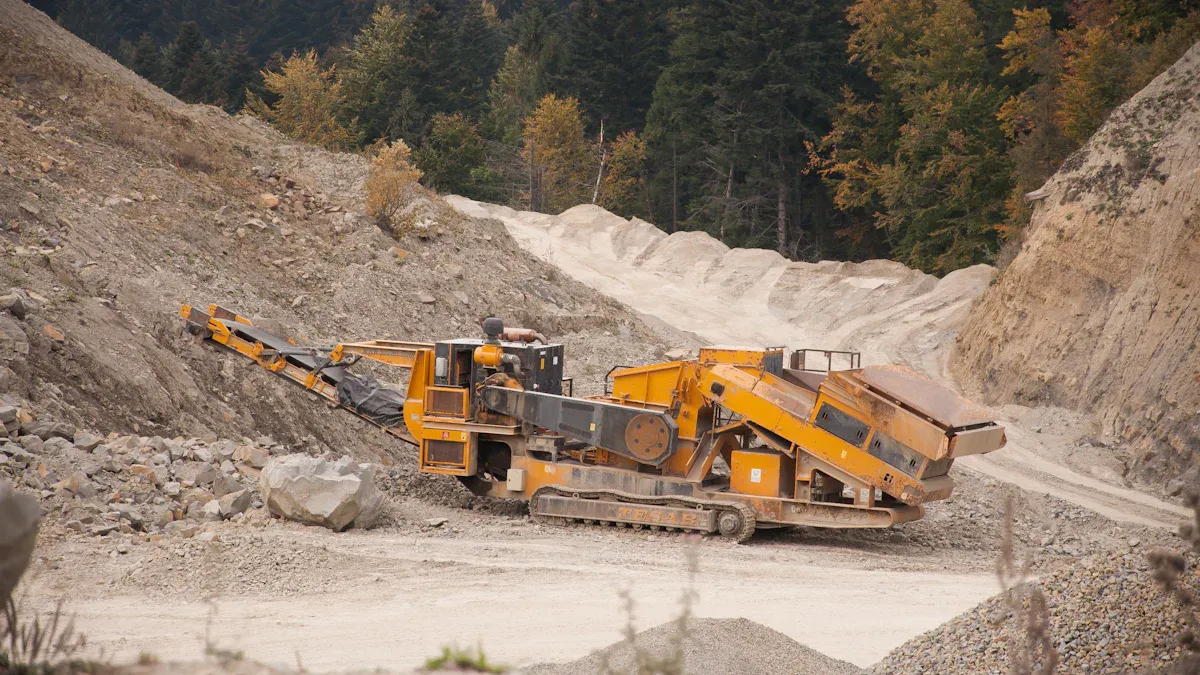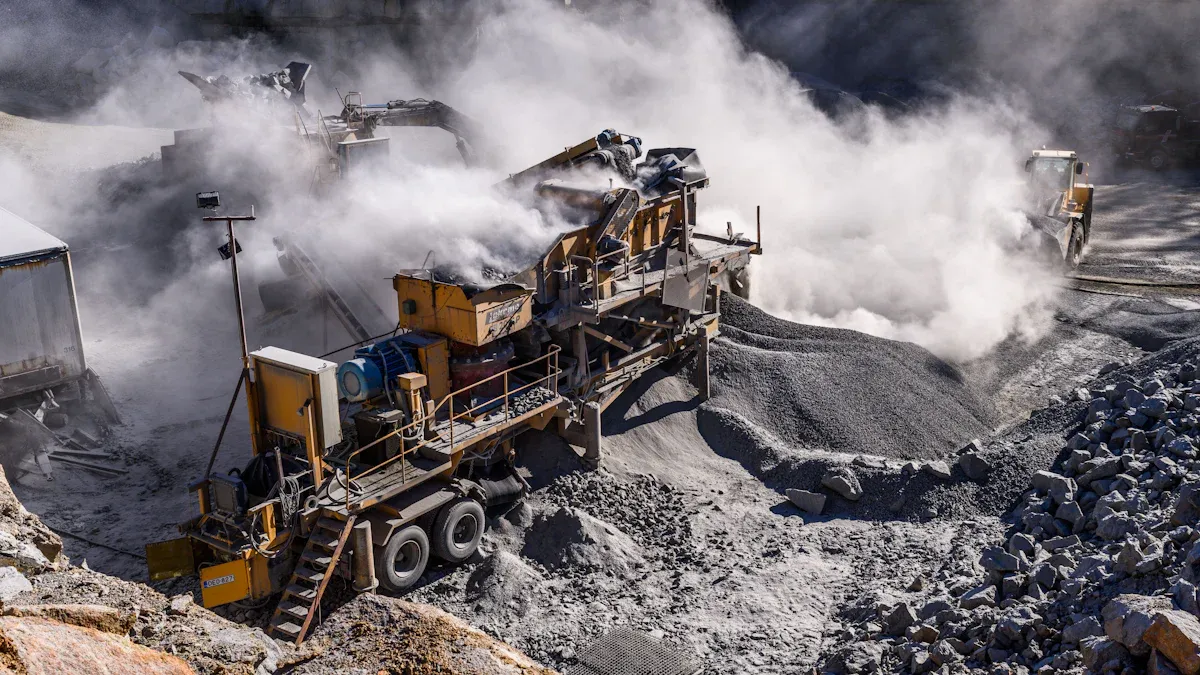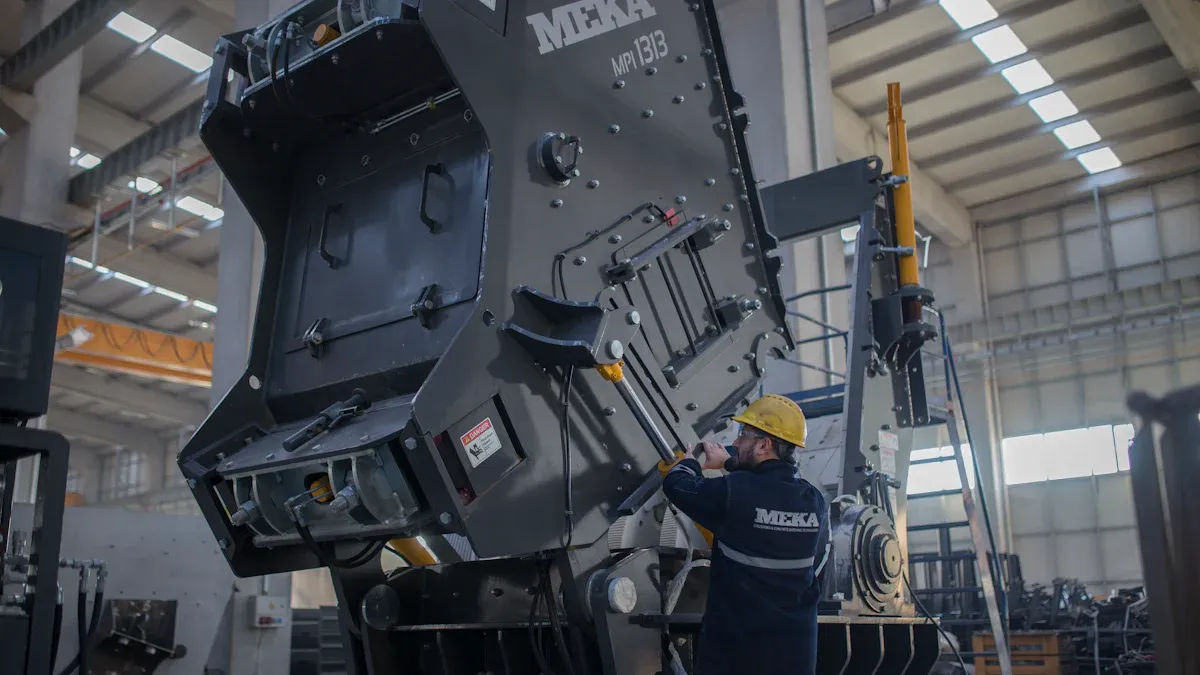
A jaw crusher hammer is a critical tool in material processing, designed to crush and break down large rocks or minerals into smaller, manageable pieces. You’ll find it at the heart of many industries, where it plays a key role in mining, construction, and recycling operations. This tool ensures efficiency by delivering high throughput and energy savings, which are essential for productivity.
Industries rely heavily on jaw crushers for their versatility. For example, mining operations use them to reduce iron ore and copper into smaller sizes, meeting the global demand for raw materials. Similarly, in construction, they recycle demolition waste and natural aggregates, promoting sustainable practices. With the hammer crusher market projected to grow at a 6% annual rate, it’s clear that this equipment is indispensable across sectors.

The jaw crusher hammer operates as a key component in the crushing process. It works by applying mechanical force to break down materials into smaller pieces. The hammer is attached to a moving jaw, which moves back and forth against a fixed jaw. This motion creates a compressive force that crushes the material placed between the two jaws.
The design of the hammer plays a crucial role in its performance. Its shape and material composition determine how effectively it can handle different types of materials. For instance, a hammer made from high-strength alloys can withstand the impact of hard rocks, ensuring durability and efficiency. The movement of the jaw is powered by a motor, which drives the eccentric shaft. This shaft converts rotational energy into the linear motion required for crushing.
The crushing process begins when you feed material into the jaw crusher. The material enters the crushing chamber, where the moving jaw compresses it against the fixed jaw. This action reduces the size of the material, making it easier to handle or process further. The hammer's impact creates fractures in the material, breaking it into smaller pieces.
The efficiency of this process depends on several factors, including the material's hardness, size, and the design of the crusher. For example, softer materials like limestone break down more easily than harder ones like granite. The energy used during crushing is distributed across various components. A significant portion of this energy is released as elastic strain energy, which contributes to the creation of new surface areas.
Here’s a breakdown of how energy is utilized during the crushing process:
| Evidence Description | Key Findings |
|---|---|
| Energy consumption related to elastic strain energy | 26% to 53% of accumulated energy in rock is released as elastic strain energy, showing a logarithmic relationship with new surface area created. |
| Specific energy consumption in crushing processes | Energy consumption of PMMA and PP was measured, highlighting the impact of crushing plate design on efficiency. |
| Energy distribution in crushers | Most energy is consumed by the kinetic energy of crushing plates and potential energy of deformation, indicating areas for efficiency improvements. |
This table illustrates how energy is distributed during the crushing process. It highlights the importance of optimizing the crusher's design to improve efficiency. By understanding these factors, you can select the right jaw crusher hammer for your needs, ensuring effective size reduction and energy savings.
A jaw crusher hammer delivers exceptional efficiency in crushing operations. Its design ensures that materials are broken down quickly and effectively, reducing processing time. Compared to other crushing tools, jaw crushers stand out for their cost-effectiveness and energy efficiency. For instance, the wear part cost for a jaw crusher is only $0.18 per ton, significantly lower than $0.31 for gyratory crushers and $0.42 for impact crushers. Additionally, jaw crushers consume 2.1 kWh per ton of material, which is more efficient than the 3.4 kWh required by impact crushers.
Mobile jaw crushers also offer operational advantages. They can be set up in just 48 hours, unlike fixed systems that take up to three weeks. This quick setup, combined with better fuel efficiency (22 liters per hour compared to 55 liters per hour for fixed systems), makes them a preferred choice for many industries. These features ensure that you can achieve high productivity while minimizing operational costs.
The durability of a jaw crusher hammer ensures reliable performance over time. Built with robust materials like cast iron or steel for the outer frame and cast steel for the jaws, these crushers are designed to withstand heavy-duty operations. The replaceable liners, often made from manganese steel or Ni-hard alloy, further enhance their longevity.
This durability translates to lower maintenance costs and fewer interruptions in your operations. A 2023 study revealed that jaw crushers have an annual maintenance cost of $180,000, significantly lower than the $420,000 required for gyratory crushers. Over a five-year lifecycle, this results in savings of $1.3 million, making jaw crushers a cost-effective choice for long-term use.
Jaw crushers excel in versatility, making them suitable for a wide range of materials. Whether you’re processing soft materials like limestone or harder ones like granite, the jaw crusher hammer adapts to your needs. Its robust construction and replaceable liners allow it to handle diverse materials effectively.
This adaptability is particularly valuable in industries like mining, construction, and recycling. For example, in mining, jaw crushers reduce large rocks into smaller sizes for further processing. In construction, they recycle demolition waste into reusable aggregates. This versatility ensures that you can rely on a jaw crusher hammer for various applications, enhancing your operational flexibility.

Jaw crushers play a vital role in various industries. Their ability to crush materials efficiently makes them indispensable in mining, construction, and recycling operations. Let’s explore how these powerful tools are used in different applications.
In mining and quarrying, jaw crushers are essential for breaking down large rocks into smaller, manageable pieces. These machines handle tough materials like granite, basalt, and iron ore. The jaw crusher hammer applies immense force to crush these materials, ensuring efficient size reduction. This process simplifies material handling and prepares it for further processing.
The demand for jaw crushers in mining continues to grow. The global hammer crusher market is projected to expand at a compound annual growth rate (CAGR) of 6%. This growth is driven by the need for cost-effective and efficient crushing solutions. Technological advancements, such as energy-efficient designs and durable materials, also contribute to this trend.
| Evidence Type | Details |
|---|---|
| Market Growth | The global Hammer Crushers market is expected to grow at a CAGR of 6%. |
| Demand Drivers | Increasing demand for efficient size reduction solutions in industries. |
| Technological Advancements | Innovations in design and materials enhance performance and durability. |
These advancements make jaw crushers a reliable choice for mining operations. Their ability to handle heavy-duty tasks ensures consistent performance, even in challenging environments.
Jaw crushers are indispensable in construction and demolition projects. They process construction debris, such as concrete, bricks, and asphalt, into reusable aggregates. This reduces waste and promotes sustainable practices.
The stone jaw crusher is particularly effective in handling demolition waste. Its robust design allows it to crush hard materials, ensuring efficient recycling. For example, crushed concrete can be reused as a base material for new construction projects. This not only saves costs but also minimizes the environmental impact of construction activities.
Mobile jaw crushers offer additional benefits in construction. They are easy to transport and set up, making them ideal for on-site crushing. Their versatility ensures that you can handle various materials without the need for multiple machines. This flexibility enhances productivity and reduces operational costs.
In recycling and waste management, jaw crushers play a crucial role in reducing the size of waste materials. They process materials like glass, plastic, and metal, making them easier to recycle. This contributes to a circular economy by turning waste into valuable resources.
Stone hammer crushers are particularly effective in recycling operations. Their powerful hammers break down materials quickly, ensuring efficient processing. For instance, crushed glass can be used in the production of new glass products, while recycled metal can be repurposed for industrial use.
The heavy-duty hammer crusher is another valuable tool in waste management. Its durable construction allows it to handle tough materials, ensuring long-term performance. By investing in industrial crushing equipment, you can improve your recycling operations and contribute to a more sustainable future.
You should inspect your jaw crusher regularly to ensure it operates efficiently. Look for signs of wear or damage on the hammer, jaws, and other components. Cracks, dents, or uneven surfaces can affect the crushing process. Cleaning the crusher is equally important. Dust, dirt, and debris can accumulate over time, reducing its performance. Use a soft brush or compressed air to remove these materials from the crushing chamber and other parts.
Tip: Schedule inspections weekly or monthly, depending on how often you use the crusher. This habit helps you catch potential issues early and avoid costly repairs.
Lubrication keeps your jaw crusher running smoothly. Apply the recommended lubricant to moving parts like the eccentric shaft and bearings. This reduces friction and prevents overheating. Monitor the wear on the hammer and jaws during lubrication. Excessive wear can lead to uneven crushing and lower efficiency.
Create a lubrication schedule based on the manufacturer's guidelines. Use high-quality lubricants to extend the life of your crusher. If you notice unusual noises or vibrations, check for lubrication issues immediately.
Replacing worn-out parts on time ensures your jaw crusher performs at its best . Pay attention to the hammer, jaws, and liners. These parts experience the most wear during crushing. Delaying replacement can lead to reduced efficiency and even damage other components.
Keep spare parts on hand to minimize downtime. When replacing parts, follow the manufacturer's instructions carefully. Proper installation ensures the new parts function correctly and last longer.
Note: Regular maintenance not only improves performance but also extends the lifespan of your crusher, saving you money in the long run.
Choosing the right hammer starts with understanding the material you need to crush. The hammer's mass, shape, and composition directly affect the production capacity of your jaw crushing machine. For example, heavier hammers can handle tougher materials, while lighter ones work better for softer materials.
You should also consider the feed size. Larger feed sizes require hammers with higher impact resistance to ensure effective crushing. Materials like limestone demand less wear resistance compared to granite, which requires durable hammers to maintain efficiency. Low-quality hammers often lead to inefficiencies, such as increased energy consumption and redu ced output.
Tip: Match the hammer's specifications to the material type and size for optimal performance and longer lifespan.
Not all hammers fit every jaw crushing machine. Before purchasing, check the compatibility between the hammer and your crusher model. Manufacturers design hammers to work with specific machines, ensuring proper alignment and functionality.
Using an incompatible hammer can cause operational issues, such as uneven crushing or damage to the crusher. Always consult the manufacturer's guidelines to confirm the hammer's suitability for your equipment. If you're upgrading your hammer crusher machine, ensure the new hammer aligns with the existing setup to avoid costly adjustments.
Balancing cost and quality is crucial when selecting a hammer. While high-quality hammers may seem expensive initially, they save money in the long run by reducing maintenance costs and improving efficiency. Durable hammers made from wear-resistant materials like manganese steel last longer and perform better under heavy loads.
On the other hand, low-cost hammers often compromise on quality, leading to frequent replacements and higher operational costs. Evaluate your budget and prioritize quality to achieve the best value for your investment.
Note: Investing in a reliable hammer ensures consistent performance and minimizes downtime, boosting your overall productivity.
The jaw crusher hammer stands out as a vital tool for crushing operations. Its efficiency, durability, and versatility make it indispensable across industries like mining, construction, and recycling. By choosing the right hammer and maintaining it properly, you can maximize its performance and lifespan.
Remember: Regular inspections, proper lubrication, and timely part replacements ensure smooth operations. Selecting a hammer that matches your material type and crusher model guarantees optimal results.
Invest in quality and care for your equipment. This approach not only boosts productivity but also saves costs in the long run. 🛠️
The jaw crusher hammer breaks down large rocks into smaller pieces. You use it to crush materials efficiently, making them easier to handle or process further.
Regularly inspect and clean the crusher. Lubricate moving parts and monitor wear. Replace worn-out parts promptly to ensure optimal performance.
Yes, jaw crushers are versatile. You can use them to crush various materials, from soft limestone to hard granite, adapting to different industry needs.
Assess the material type, size, and hardness. Ensure compatibility with your crusher model. Balance cost-effectiveness with quality for the best results.
Jaw crushers reduce waste materials like glass and metal into smaller sizes. You can recycle these materials efficiently, contributing to a sustainable future. ♻️